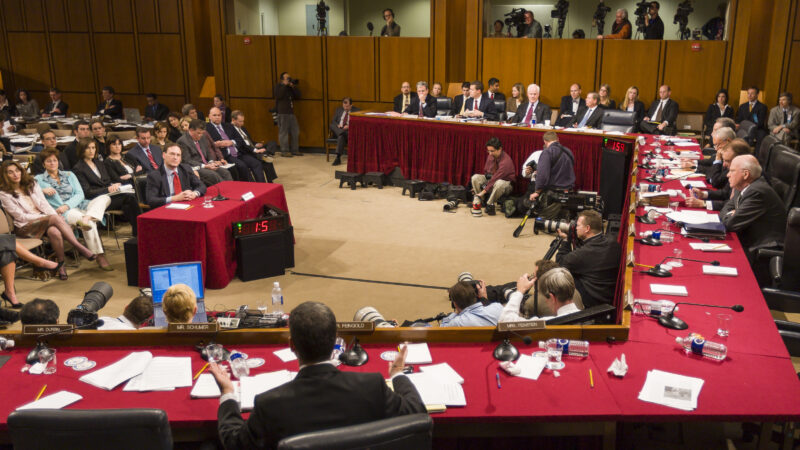Ian Bassin is co-founder and Executive Director of Protect Democracy. He previously served as Associate White House Counsel, where he counseled the President and senior White House staff on administrative and constitutional law.
Revitalizing the Ku Klux Klan Act to Protect Voters
- July 4, 2021

Becca Leviss also contributed to this analysis.
Frustrated by the federal government’s persistent inability to put a stop to white supremacist terrorism by the Ku Klux Klan, Congress passed the Ku Klux Klan Act of 1871 to put an end to the Klan’s reign of terror. The bill enacted a comprehensive strategy to respond to the Klan’s coordinated political violence and intimidation. The new law included a range of provisions. It gave the president the power to call on the Army, Navy, and militia to respond to local rebellions. It ensured that federal judges could keep Klan conspirators off of juries. And it included a famous provision of American civil rights law, allowing people to sue in federal court when state and local officials violate their federal civil rights (42 U.S.C. § 1983).
The bill also allowed private individuals to bring claims in federal court in response to conspiracies to interfere with civil or political rights. In the language of section 5 of the Act (now codified at 42 U.S.C. § 1985), a federal claim could be brought “if two or more persons conspire to prevent by force, intimidation, or threat, any citizen who is lawfully entitled to vote, from giving his support or advocacy in a legal manner, toward or in favor of the election of any lawfully qualified person as an elector for President or Vice President, or as a Member of Congress of the United States; or to injure any citizen in person or property on account of such support or advocacy.” And even more so, individuals could bring a federal case against those who knew about a conspiracy to violate political rights, could have had the power to stop it, and failed to do so.
At the time Congress enacted the Klan Act, these provisions held particular promise for deterring and holding accountable acts of political violence and voter intimidation. At the heart of the Klan’s activities were conspiracies to harm Black people and their allies for exercising their political rights. And at a time when many political actors and government officials (including, for example, local law enforcement throughout the South) would regularly turn a blind eye to—or even incite or participate in—these kinds of conspiracies, civil litigation in independent federal courts provided an important tool for ensuring accountability and deterrence to stop this kind of intimidation.
After the bill’s passage, President Grant and the Department of Justice set out to break the power of the Klan in the South, and they largely succeeded. Attorney General Amos Ackerman oversaw the arrest and conviction of hundreds of Klansmen, and by 1872-73 the Klan had been effectively crushed. Racist white supremacist terrorism would continue throughout the South, but it wasn’t until the Klan’s 1915 re-establishment by William J. Simmons that the Klan reemerged as a powerful force in American politics.
With the end of Reconstruction, Klan Act litigation precipitously declined—a trend that accelerated further after the Supreme Court found some (but not all) portions of the Klan Act’s criminal enforcement provisions unconstitutional, and Congress repealed at least one other. With the exception of Section 1 of the Klan Act (§ 1983), the remaining provisions of the Klan Act largely faded into obscurity for over a century.
We filed a suit in 2018 to establish that the same Ku Klux Klan Act that was designed in 1871 to stop efforts of voter intimidation then could also be used
to stop analogous, even if digital, efforts now. And we won. The Judge agreed with our legal argument whole cloth.
In particular, Klan Act civil litigation under § 1985 and 1986 for voter intimidation conspiracies was quite rare from 1880-2016. That’s not to say that the provision was never used. Civil rights lawyers occasionally invoked the provision to protect voter registration and demand protection from the Klan and the American Nazi Party. In the late 1970s, a Freedom Rider used it against FBI agents for failing to protect him in the face of known risks of white supremacist violence in Alabama. And in several cases, political entities used it to address conspiracies aimed at interfering with Americans’ abilities to participate in the political process. For example, members of the Democratic National Committee used it to sue the Watergate burglars.
In recent years, we’ve seen new forms of political intimidation and violence, with authoritarian-minded actors conspiring together to prevent full and open participation in the political process. So, over the last four years, Protect Democracy has set out to use the legal tools made available by the Klan Act to combat the alarming trend of increased political violence and conspiracies to intimidate voters, especially voters from communities of color.
In 2017, we filed a case under the Act on behalf of several individuals whose personal, private information was leaked to the world after Russian hackers broke into the DNC’s computer systems. In some cases, our clients’ social security numbers were dumped on the web and their identities stolen as a result. We sued the Trump Campaign on their behalf, alleging that its involvement with Russian actors and others responsible for the hacking and dumping of this private personal information amounted to a conspiracy to punish and intimidate people for engaging in political activity (our clients’ information ended up hacked and online because they were donors to the DNC). The case was ultimately dismissed (for reasons with which we continue to disagree), even though subsequent revelations make even clearer that people within the Trump Campaign at least knew of the Russian hacking and appeared to take steps to try to profit from it politically.
While the case was dismissed, it required a deep dive into the history and application of the Klan Act, and helped Protect Democracy develop Klan Act knowledge in some of its rarely used provisions—particularly the clause in §1985 described above, which permits federal civil litigation for conspiracies targeting people for their involvement in the political process.
The Klan Act has been used more and more since 2017 in situations core to the reasons it was first enacted. The Act was a powerful response to political violence and voter intimidation in the post-Reconstruction era, and our experience has taught us and others that it can be an important tool for justice and democracy again today.
In early 2018, we applied this knowledge by filing suit in another matter to vindicate the rights of U.S. citizens in Virginia who had been falsely accused of voting illegally under the mistaken view that they actually were not citizens. These false accusations were part of a report that was published entitled “Alien Invasion” by an organization run by someone with a long history of voter fraud alarmism. The report didn’t just wrongly suggest that Virginians were committing felonies by voting illegally, it also contained their names and addresses (and sometimes even had some folks’ social security numbers). The report made its way online, meaning that the individuals listed in the report had to be afraid that every knock on the door or every call on the phone might be a threat to their safety.
So we sued under the Klan Act. And not just to stop replication of this particular report, but to establish that the same Ku Klux Klan Act that was designed in 1871 to stop efforts of voter intimidation then could also be used in 2018 to stop analogous, even if digital, efforts now. And we won. The Judge—an appointee of President George W. Bush—agreed with our legal argument whole cloth.
Following those two cases, two of the lawyers who worked on them published a law review article sharing our research, analysis, and demonstrated use cases for the Klan Act in a modern context. One of our Harvard Law School clinic participants published a note on the topic in the Harvard Law Review. We have since shared those articles with other litigators to ensure the lessons we’ve learned can help others further revive the Klan Act in an era of increased political violence and voter intimidation.
And indeed, the Klan Act has been used more and more frequently since in situations core to the reasons it was first enacted. For example, Members of Congress and injured Capitol Police officers have filed Klan Act suits against the alleged perpetrators of the January 6 attacks (we are co-counsel in the latter of those suits). Victims of the “Unite the Right” rally in Charlottesville have used the Act to sue neo-Nazis. New York voters have successfully used the provision to sue two individuals for sending robocalls with false information wrongly suggesting that folks who voted by mail could be subject to warrant checks and credit checks. And just this year, we invoked the Klan Act again in two suits over the dangerous incident last Fall in which a caravan of Trump supporters ambushed a Biden-Harris campaign bus on a Texas highway and ran it out of town while calls for help from local law enforcement went unheeded.
Ta-Nehisi Coates has written about how the post-Obama era bears similarities with the era of post-Reconstruction. Sadly, one of those is a rise in political violence and voter intimidation. The Klan Act was a powerful response back then, and our experience has taught us and others that it can be an important tool for justice and democracy again today.
Related Content
Join Us.
Building a stronger, more resilient democracy is possible, but we can’t do it alone. Become part of the fight today.
Donate
Sign Up for Updates Sign Up for Updates
Explore Careers Explore Careers
How to Protect Democracy How to Protect Democracy



